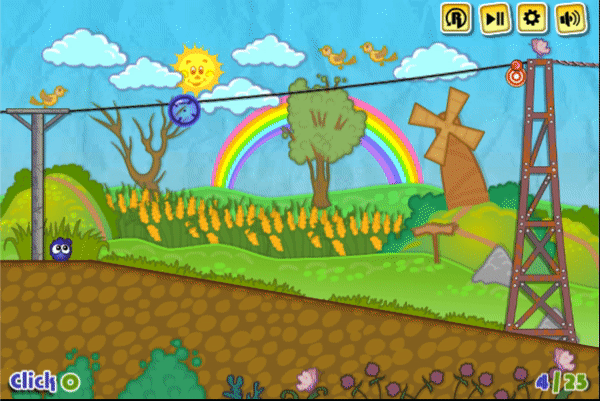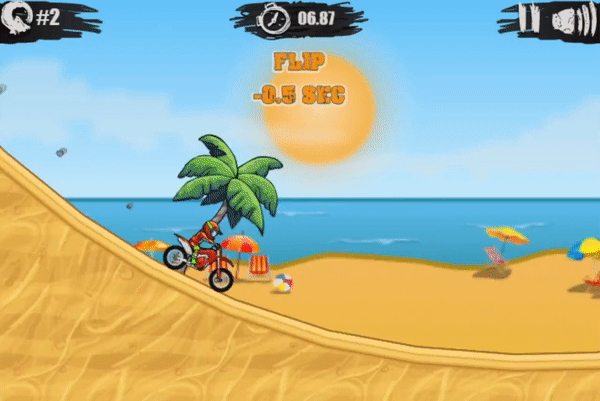| Why Web Gaming Died, And How Its Coming Back |
 |
 |
| In the first decade of the 21st century, web-based games had a moment.
In 2005, Neopets reported 35 million unique monthly active players. Big game portals like Miniclip and Kongregate were recording literally billions of monthly visits. And a mix of viable business models proliferated.
But by 2010, things had taken a turn. Mobile gaming took off, and Steve Jobs launched an attack on Adobe Flash that heralded the eventual discontinuation of a technology that was foundational for web games of the era.
But now, finally, new possibilities for web games are emerging. Could they be poised for a comeback?
This week we spoke with web gaming pioneers Emily Greer (co-founder and former CEO of Kongregate), and Rob Small (co-founder and President of Miniclip), as well as a handful of startup founders on the cutting edge of the nascent web gaming renaissance.
That story below. But first, this week’s news from the future. |
 |
Rob Small was an early believer in the potential for web games. “The idea for Miniclip began amidst the excitement of the late 1990's dot-com boom,” Small says.
He and co-founder Tihan Presbie “saw a huge opportunity to democratize gaming across the globe by distributing games freely over the internet.”
The company was officially founded in 2001, and quickly found a viral hit with the release of Dancing Bush, an interactive animation that allowed players to make a big-headed George W. Bush perform a variety of spins, thrusts, and screaming leaps. Small says the game clocked up over a billion plays.
From there, it was off to the races. Without raising funds or spending on marketing, Small and Presbie turned Miniclip.com into a gaming empire, with over 1,000 games at its peak. Bored kids in computer labs around the world logged on and played hits like Trials Bike Pro, Heli Attack 2, and Bubble Trouble.A critical early decision by the Miniclip team was to allow people to embed any Miniclip game on their own website simply by copying-and-pasting HTML code. This effectively worked as a hack to juice Miniclip.com’s PageRank rating. “This served as a great way to boost our web traffic and SEO,” Small says, “ultimately securing us the #1 search position from the one billion pages listed under ‘Games’ on Google.”
In 2008, Small says, Miniclip’s more “tech-savvy” players started to migrate from web to mobile. At first, Small and his team were inclined to try to fight the trend, but after a couple of years they began dabbling in mobile games publishing with titles like Monster Trucks Nitro and Fragger, the latter of which went on to become one of App Store’s highest-grossing games in the first half of the 2010s.
Miniclip began its transformation into a mobile-first company, and was ultimately acquired by Tencent. It’s now primarily known for launching and acquiring mobile megahits like Subway Surfers, though it still operates the wildly popular web games Agar.io and 8 Ball Pool.
It reads like a simple, straightforward story. Web games rose and fell because—while the games were sticky—mobile simply did it better.
|
| The Three Audiences Hypothesis |
Browser games have never been cool,” says Emily Greer. “but they’re also never as dead as people think they are.” Greer woul
d know. She and her brother Jim co-founded Kongregate,
one of the few giants of the early 2000s web game ma
nia to both survive the pivot to mobile and keep the web
gaming part of the business going. Kongregate’s website sti
ll hosts more than 100,000 playable games. Kong, as its fans
and employees call it, was a relative latecomer to the web gam
e wars—the Greers launched it in 2006. But it quickly became
one of the biggest players in the space, in part because it hos
ted a tremendous number of games. Many have marveled at th
e fact that Steam now gets over 14,000 games uploaded per ye
ar, but Greer (who left the company in 2019) says that Kongregat
e was outpacing that shortly after the platform launched. “We were
getting like 1,300 to 1,500 new games uploaded every month in 2008,
” Greer says. And because Kongregate embraced in-app purchases earl
y on, the company was making more money than many of its competit
ors, which were more reliant solely on ad revenue. “Ad revenue grew
steadily with our traffic,” Greer says, “but by the peak, 80% of
revenue came from IAP. I’ve never talked about total amounts,
but we had a lot of games where average revenue per paying user was $200 or $300.” Greer says that she saw three basic types of web game players. The first is what she calls the
deep casual audience, “like people who play games every day, but don’t think of themselves as gamers.” These players have a focus on puzzle game and card game,
, maybe daily games like Wordle and Spelling Bee. For this audience, Greer says, “The accessibility of the device—it being something they have with them all the time—is very important.” Greer thinks many in the deep casual audience graduated from web game portals like Pogo or Yahoo! Games to Candy Crush on mobile, and may now be beginning to move on to daily games like those offered by the New York Times. The second audience Greer noticed were fans of hypercasual games, which Greer describes as “these sort of viral games, simple mechanics, somewhat disposable, not necessarily great graphics, but with really great hooks.” Browser technology, she says, has always been great for hypercasual games, “because it's about getting people in and playing quickly.” This audience also migrated to mobile, Greer says, but the trend in recent years has looked rough for the hypercasual category. “Mobile took that over for a while, but with IDFA deprecation, they're not able to do quite so much aggressive marketing,” she says. “I wouldn't be surprised if some of that is moving back to web. I think if you think of Messenger games and other things like that, that fits into that pattern as well.” The third and final audience for web games, in Greer’s analysis, are those who could be described as access disadvantaged. On Kongregate, Greer says, “shooters were tremendously popular, but if you look at the geos, it was Turkey, Brazil, Indonesia, Russia. So if console penetration was high, then shooters were generally not being played so much on browser.
|
 |
But if that was the best way you had to play this type of game, then that's how you were going to play it.” Differences in geographic distribution of gaming hardware is only one way players could be access disadvantaged. Greer lists “kids who don't have access to a console or a PC yet who are playing browser and flash games at school and evading school network detection. It could be geographic, financial, age-related.” Mobile absolutely slammed web games for access-disadvantaged players as well, because of the convenience of the devices. “Mobile became dominant because it was a more convenient device. And then PC is the most powerful and beautiful and performant. So when web is winning, it's because it's meeting some access needs and filling in some niche that those two things aren’t doing—it's coming in between.” If web games were to come back in any meaningful way, then, they’d need to deliver a majorly leveled-up experience in terms of both access and performance. You’d want to either see them once again offering the best experience for those three audiences, or delivering a whole new type of value to reach a different audience. A new class of startup founders believes that the next generation of web games is poised to do just that. |
The Next Generation of Web Gaming |
| To understand the real potential of web games, it helps to think beyond web browsers. Three companies, each of them participants in A16Z GAMES SPEEDRUN, are placing bets on web games breaking out via new distribution channels.
Sami Ramly, founder of Echo Chunk AI and the web-based game Echo Chess says he finds it “funny we still call them ‘browser games’ in the industry. You can build anything you want with a web stack nowadays.”
Web games can be distributed using browsers, of course, but they can also be live inside more traditional apps. Discord’s new Activities platform (see story above), for example, lets players host web-based experiences directly in their Discord server. “We're big fans of Discord,” says Ramly.
Ramly also believes that the over-proliferation of apps has created an opportunity for developers. “The conventional wisdom is that if an app doesn't live on your phone's home screen, that app doesn't exist,” says Ramly. “I think this maybe was a solid argument 5-10 years ago because having an app you love right there on your home screen was a great reminder of a daily habit you're forming. But these days most people have so much app fatigue and so many apps on their phones that grooming your home screen is a chore in itself. You even have to search for the app you're thinking of!”
” |
|
To understand the real potential of web games, it helps to think beyond web browsers. Three companies, each of them participants in A16Z GAMES SPEEDRUN, are placing bets on web games breaking out via new distribution channels. Sami Ramly, founder of Echo Chunk AI and the web-based game Echo Chess says he finds it “funny we still call them ‘browser games’ in the industry. You can build anything you want with a web stack nowadays.” Web games can be distributed using browsers, of course, but they can also be live inside more traditional apps. Discord’s new Activities platform (see story above), for example, lets players host web-based experiences directly in their Discord server. “We're big fans of Discord,” says Ramly. Ramly also believes that the over-proliferation of apps has created an opportunity for developers. “The conventional wisdom is that if an app doesn't live on your phone's home screen, that app doesn't exist,” says Ramly. “I think this maybe was a solid argument 5-10 years ago because having an app you love right there on your home screen was a great reminder of a daily habit you're forming. But these days most people have so much app fatigue and so many apps on their phones that grooming your home screen is a chore in itself. You even have to search for the app you're thinking of!” ”
“ Travis Chen, co-founder of daily web gaming startup Lil Snack, agrees, in part because web games avoid the hassle of app installs. “Players are able to experience Lil Snack for the first time within seconds of clicking a link from a shared text message, Slack or Tweet,” Chen says. “They never have to navigate to an app store, initiate a download or even open an app.Chen argues that the distribution options for web games are powerful as well: “The universal support of web browsers has given us the flexibility to embed our Lil Snack daily games on partner websites and within existing native apps,” Chen says. Perhaps the most important factor in favor of web games these days is the development of new technologies that allow developers to build bigger and better games. One consistent theme you’ll hear from web game developers is that the death of Flash took away one of the best toolsets for making games. And now, finally, developers are close to replacing what was lost. The evolution of HTML5 in game engines like Unity and PlayCanvas has allowed us to feasibly build games for the web using tools comfortable for game designers and developers,” says Chen. The development of HTML5’s capabilities has been slow, to be sure, but Brandon Dillon, CEO and Co-Founder of 2weeks Corp, says that the technical gap between web-based games and more traditional games is closing. “The biggest opportunity for web games is that capabilities are converging with native hardware capabilities,” Dillon says. “Historically, web tech didn't have the performance or responsiveness needed to build games that were competitive with traditional gaming platforms. This was true even in the height of the Flash era, the last big wave of web game—you could build some pretty credible 2D games in Flash, and there was a ton of fun and innovative stuff getting made, but no one would mistake them for PC and console games of the era.” But in recent years, Dillon says, web technology has been catching up. “By the time WebGL 1.0 was widely deployed, it was already pretty out-of-date in terms of graphics tech,” says Dillon. “WebGL 2.0 has become broadly available in the last couple of years, but is only about one generation behind, with capabilities roughly equivalent to what you can do on a Nintendo Switch. WebGPU is starting to roll out, and is basically current (of course, by the time it's widely deployed, it'll probably be a generation behind too, but the point is the gap is closing). Games can also take advantage of WebAssembly, which unlocks something like 85-90% of native CPU performance.” The end result, Dillon says, is that “Web games can now do most of the things games on other platforms can do, and the gap is shrinking over time.” Of course, web games will still face their own sets of challenges and limitations. The inability to rely on large initial installs means AAA games can’t feasibly run natively on web platforms, and by definition web technology requires that developers support a ridiculously wide range of devices, many of which are low-end. But Dillon says developers should see these limitations as an opportunity: “The constraints of the web encourage you to build experiences that can run on a wide range of hardware and that players can get into instantly. These are exactly the things you want to optimize for if you want an experience that's primed for discovery and growth |
Why Web Gaming Died, And How Its Coming Back


In the first decade of the 21st century, web-based games had a moment.
In 2005, Neopets reported 35 million unique monthly active players. Big game portals like Miniclip and Kongregate were recording literally billions of monthly visits. And a mix of viable business models proliferated.
But by 2010, things had taken a turn. Mobile gaming took off, and Steve Jobs launched an attack on Adobe Flash that heralded the eventual discontinuation of a technology that was foundational for web games of the era.
But now, finally, new possibilities for web games are emerging. Could they be poised for a comeback?
This week we spoke with web gaming pioneers Emily Greer (co-founder and former CEO of Kongregate), and Rob Small (co-founder and President of Miniclip), as well as a handful of startup founders on the cutting edge of the nascent web gaming renaissance.
That story below. But first, this week’s news from the future.


Rob Small was an early believer in the potential for web games. “The idea for Miniclip began amidst the excitement of the late 1990's dot-com boom,” Small says.
He and co-founder Tihan Presbie “saw a huge opportunity to democratize gaming across the globe by distributing games freely over the internet.”
The company was officially founded in 2001, and quickly found a viral hit with the release of Dancing Bush, an interactive animation that allowed players to make a big-headed George W. Bush perform a variety of spins, thrusts, and screaming leaps. Small says the game clocked up over a billion plays.
From there, it was off to the races. Without raising funds or spending on marketing, Small and Presbie turned Miniclip.com into a gaming empire, with over 1,000 games at its peak. Bored kids in computer labs around the world logged on and played hits like Trials Bike Pro, Heli Attack 2, and Bubble Trouble.A critical early decision by the Miniclip team was to allow people to embed any Miniclip game on their own website simply by copying-and-pasting HTML code. This effectively worked as a hack to juice Miniclip.com’s PageRank rating. “This served as a great way to boost our web traffic and SEO,” Small says, “ultimately securing us the #1 search position from the one billion pages listed under ‘Games’ on Google.”
In 2008, Small says, Miniclip’s more “tech-savvy” players started to migrate from web to mobile. At first, Small and his team were inclined to try to fight the trend, but after a couple of years they began dabbling in mobile games publishing with titles like Monster Trucks Nitro and Fragger, the latter of which went on to become one of App Store’s highest-grossing games in the first half of the 2010s.
Miniclip began its transformation into a mobile-first company, and was ultimately acquired by Tencent. It’s now primarily known for launching and acquiring mobile megahits like Subway Surfers, though it still operates the wildly popular web games Agar.io and 8 Ball Pool.
It reads like a simple, straightforward story. Web games rose and fell because—while the games were sticky—mobile simply did it better.
But that raises some complicated questions. What were the real driving motivations, the player needs, that pushed so many tens of millions of people to play web games in the first place? And did mobile apps really meet all of those needs better?
Emily Greer has a theory. A critical early decision by the Miniclip team was to allow people to embed any Miniclip game on their own website simply by copying-and-pasting HTML code. This effectively worked as a hack to juice Miniclip.com’s PageRank rating. “This served as a great way to boost our web traffic and SEO,” Small says, “ultimately securing us the #1 search position from the one billion pages listed under ‘Games’ on Google.”
In 2008, Small says, Miniclip’s more “tech-savvy” players started to migrate from web to mobile. At first, Small and his team were inclined to try to fight the trend, but after a couple of years they began dabbling in mobile games publishing with titles like Monster Trucks Nitro and Fragger, the latter of which went on to become one of App Store’s highest-grossing games in the first half of the 2010s.
Miniclip began its transformation into a mobile-first company, and was ultimately acquired by Tencent. It’s now primarily known for launching and acquiring mobile megahits like Subway Surfers, though it still operates the wildly popular web games Agar.io and 8 Ball Pool.
It reads like a simple, straightforward story. Web games rose and fell because—while the games were sticky—mobile simply did it better.
But that raises some complicated questions. What were the real driving motivations, the player needs, that pushed so many tens of millions of people to play web games in the first place? And did mobile apps really meet all of those needs better?
Emily Greer has a theory
The Three Audiences Hypothesis
Browser games have never been cool,” says Emily Greer. “but they’re also never as dead as people think they are.” Greer woul
d know. She and her brother Jim co-founded Kongregate,
one of the few giants of the early 2000s web game ma
nia to both survive the pivot to mobile and keep the web
gaming part of the business going. Kongregate’s website sti
ll hosts more than 100,000 playable games. Kong, as its fans
and employees call it, was a relative latecomer to the web gam
e wars—the Greers launched it in 2006. But it quickly became
one of the biggest players in the space, in part because it hos
ted a tremendous number of games. Many have marveled at th
e fact that Steam now gets over 14,000 games uploaded per ye
ar, but Greer (who left the company in 2019) says that Kongregat
e was outpacing that shortly after the platform launched. “We were
getting like 1,300 to 1,500 new games uploaded every month in 2008,
” Greer says. And because Kongregate embraced in-app purchases earl
y on, the company was making more money than many of its competit
ors, which were more reliant solely on ad revenue. “Ad revenue grew
steadily with our traffic,” Greer says, “but by the peak, 80% of
revenue came from IAP. I’ve never talked about total amounts,
but we had a lot of games where average revenue per paying user was $200 or $300.” Greer says that she saw three basic types of web game players. The first is what she calls the
deep casual audience, “like people who play games every day, but don’t think of themselves as gamers.” These players have a focus on puzzle game and card games

, maybe daily games like Wordle and Spelling Bee. For this audience, Greer says, “The accessibility of the device—it being something they have with them all the time—is very important.” Greer thinks many in the deep casual audience graduated from web game portals like Pogo or Yahoo! Games to Candy Crush on mobile, and may now be beginning to move on to daily games like those offered by the New York Times. The second audience Greer noticed were fans of hypercasual games, which Greer describes as “these sort of viral games, simple mechanics, somewhat disposable, not necessarily great graphics, but with really great hooks.” Browser technology, she says, has always been great for hypercasual games, “because it's about getting people in and playing quickly.” This audience also migrated to mobile, Greer says, but the trend in recent years has looked rough for the hypercasual category. “Mobile took that over for a while, but with IDFA deprecation, they're not able to do quite so much aggressive marketing,” she says. “I wouldn't be surprised if some of that is moving back to web. I think if you think of Messenger games and other things like that, that fits into that pattern as well.” The third and final audience for web games, in Greer’s analysis, are those who could be described as access disadvantaged. On Kongregate, Greer says, “shooters were tremendously popular, but if you look at the geos, it was Turkey, Brazil, Indonesia, Russia. So if console penetration was high, then shooters were generally not being played so much on browser.

But if that was the best way you had to play this type of game, then that's how you were going to play it.” Differences in geographic distribution of gaming hardware is only one way players could be access disadvantaged. Greer lists “kids who don't have access to a console or a PC yet who are playing browser and flash games at school and evading school network detection. It could be geographic, financial, age-related.” Mobile absolutely slammed web games for access-disadvantaged players as well, because of the convenience of the devices. “Mobile became dominant because it was a more convenient device. And then PC is the most powerful and beautiful and performant. So when web is winning, it's because it's meeting some access needs and filling in some niche that those two things aren’t doing—it's coming in between.” If web games were to come back in any meaningful way, then, they’d need to deliver a majorly leveled-up experience in terms of both access and performance. You’d want to either see them once again offering the best experience for those three audiences, or delivering a whole new type of value to reach a different audience. A new class of startup founders believes that the next generation of web games is poised to do just that.
The Next Generation of Web Gaming

To understand the real potential of web games, it helps to think beyond web browsers. Three companies, each of them participants in A16Z GAMES SPEEDRUN, are placing bets on web games breaking out via new distribution channels.
Sami Ramly, founder of Echo Chunk AI and the web-based game Echo Chess says he finds it “funny we still call them ‘browser games’ in the industry. You can build anything you want with a web stack nowadays.”
Web games can be distributed using browsers, of course, but they can also be live inside more traditional apps. Discord’s new Activities platform (see story above), for example, lets players host web-based experiences directly in their Discord server. “We're big fans of Discord,” says Ramly.
Ramly also believes that the over-proliferation of apps has created an opportunity for developers. “The conventional wisdom is that if an app doesn't live on your phone's home screen, that app doesn't exist,” says Ramly. “I think this maybe was a solid argument 5-10 years ago because having an app you love right there on your home screen was a great reminder of a daily habit you're forming. But these days most people have so much app fatigue and so many apps on their phones that grooming your home screen is a chore in itself. You even have to search for the app you're thinking of!”
”
“ Travis Chen, co-founder of daily web gaming startup Lil Snack, agrees, in part because web games avoid the hassle of app installs. “Players are able to experience Lil Snack for the first time within seconds of clicking a link from a shared text message, Slack or Tweet,” Chen says. “They never have to navigate to an app store, initiate a download or even open an app.Chen argues that the distribution options for web games are powerful as well: “The universal support of web browsers has given us the flexibility to embed our Lil Snack daily games on partner websites and within existing native apps,” Chen says.
Perhaps the most important factor in favor of web games these days is the development of new technologies that allow developers to build bigger and better games. One consistent theme you’ll hear from web game developers is that the death of Flash took away one of the best toolsets for making games.
And now, finally, developers are close to replacing what was lost. The evolution of HTML5 in game engines like Unity and PlayCanvas has allowed us to feasibly build games for the web using tools comfortable for game designers and developers,” says Chen.
The development of HTML5’s capabilities has been slow, to be sure, but Brandon Dillon, CEO and Co-Founder of 2weeks Corp, says that the technical gap between web-based games and more traditional games is closing.
“The biggest opportunity for web games is that capabilities are converging with native hardware capabilities,” Dillon says. “Historically, web tech didn't have the performance or responsiveness needed to build games that were competitive with traditional gaming platforms. This was true even in the height of the Flash era, the last big wave of web game—you could build some pretty credible 2D games in Flash, and there was a ton of fun and innovative stuff getting made, but no one would mistake them for PC and console games of the era.”
But in recent years, Dillon says, web technology has been catching up.
“By the time WebGL 1.0 was widely deployed, it was already pretty out-of-date in terms of graphics tech,” says Dillon. “WebGL 2.0 has become broadly available in the last couple of years, but is only about one generation behind, with capabilities roughly equivalent to what you can do on a Nintendo Switch. WebGPU is starting to roll out, and is basically current (of course, by the time it's widely deployed, it'll probably be a generation behind too, but the point is the gap is closing). Games can also take advantage of WebAssembly, which unlocks something like 85-90% of native CPU performance.”
The end result, Dillon says, is that “Web games can now do most of the things games on other platforms can do, and the gap is shrinking over time.”
Of course, web games will still face their own sets of challenges and limitations. The inability to rely on large initial installs means AAA games can’t feasibly run natively on web platforms, and by definition web technology requires that developers support a ridiculously wide range of devices, many of which are low-end.
But Dillon says developers should see these limitations as an opportunity: “The constraints of the web encourage you to build experiences that can run on a wide range of hardware and that players can get into instantly. These are exactly the things you want to optimize for if you want an experience that's primed for discovery and growth














